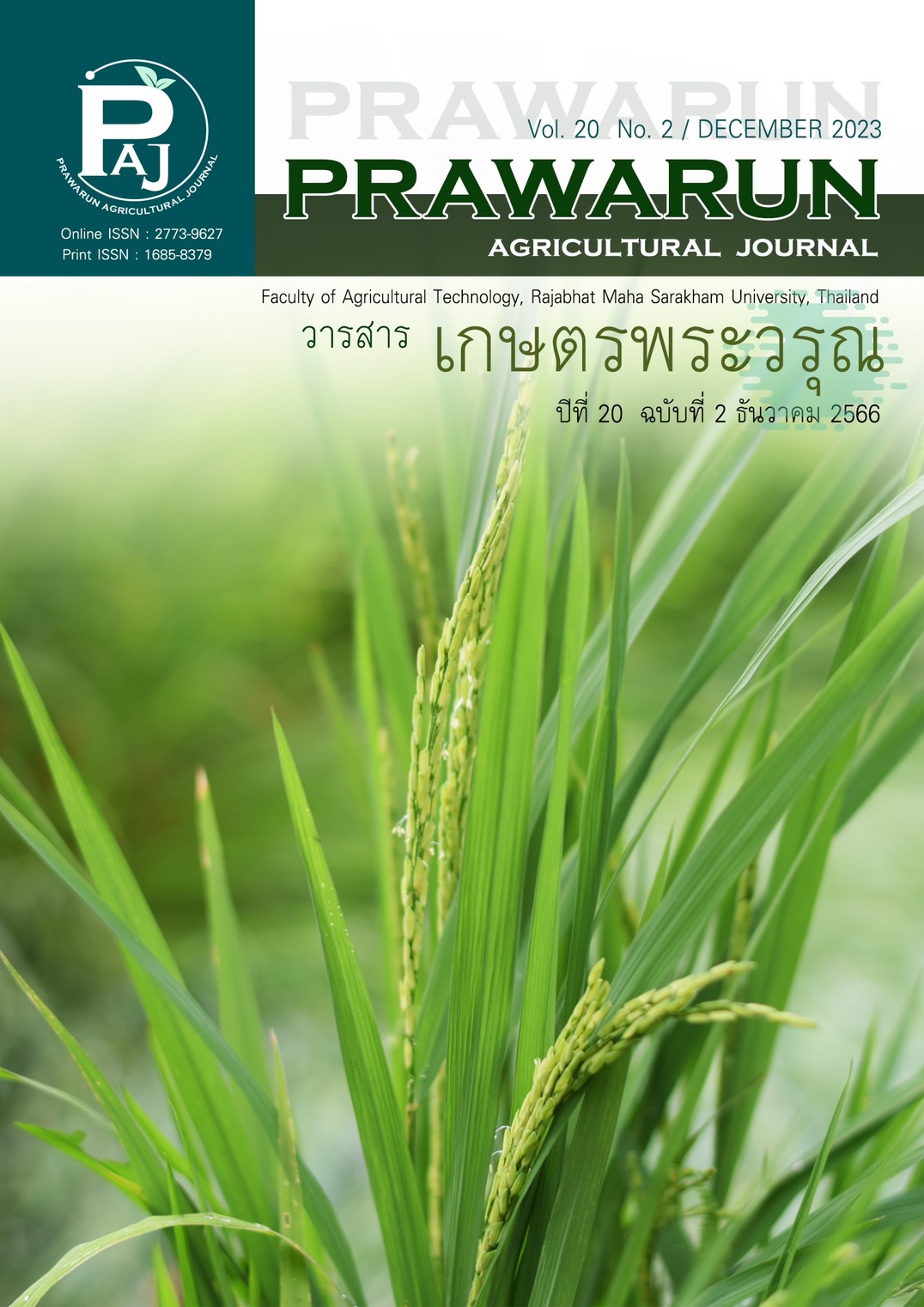การใช้ปลายข้าวไรส์เบอรี่เป็นอาหารไก่ไข่ ต่อปริมาณผลผลิตไข่ คุณภาพไข่ และค่าชี้วัดในเลือดของไก่ไข่ที่เลี้ยงในโรงเรือนแบบเปิด
Main Article Content
บทคัดย่อ
ปลายข้าวไรส์เบอรี่เป็นผลพลอยได้ทางการเกษตรที่มีปริมาณมากและมีสารต้านอนุมูลอิสระ การวิจัยนี้มีวัตถุประสงค์เพื่อศึกษาผลของการใช้ปลายข้าวไรส์เบอร์รี่เป็นอาหารไก่ไข่ต่อผลผลิตไข่ คุณภาพไข่ และค่าชี้วัดในเลือดไก่ไข่ที่เลี้ยงในโรงเรือนแบบเปิด วางแผนการทดลองแบบสุ่มสมบูรณ์ (completely randomized design, CRD) ใช้ไก่พันธุ์ โลมันบราวน์อายุ 41 สัปดาห์จำนวน 90 ตัว แบ่งออกเป็น 3 กลุ่มทดลอง กลุ่มที่ 1 ใช้ข้าวโพดบดที่ระดับร้อยละ 40 (C) กลุ่มที่ 2 ใช้ปลายข้าวขาวที่ระดับร้อยละ 40 (BR) กลุ่มที่ 3 ใช้ปลายข้าวไรส์เบอรี่ที่ระดับร้อยละ 40 (RBR) ผลการทดลองพบว่าน้ำหนักเมื่อสิ้นสุดการทดลอง ปริมาณอาหารที่กินต่อวัน ปริมาณผลผลิตไข่ น้ำหนักไข่ มวลไข่ อัตราการเปลี่ยนอาหาร ดัชนีไข่แดง ความสูงไข่ขาว ความหนาของเปลือกไข่ และค่าฮอกยูนิต ทุกกลุ่มไม่แตกต่างกัน (p > 0.05) ส่วนค่าสีไข่แดงกลุ่ม RBR ต่ำกว่ากลุ่ม C (p < 0.05) แต่ไม่แตกต่างกับกลุ่ม BR อย่างไรก็ตามกลุ่ม RBR มีสัดส่วนของเม็ดเลือดขาวเฮทเทอโรฟิล (H) ต่อลิมโพไซท์ (L) ต่ำกว่ากลุ่มอื่น (p < 0.05) อีกทั้งยังลดต้นทุนค่าอาหารต่อการผลิตไข่ได้ 2.90 บาทต่อกิโลกรัม (p < 0.05) สรุปปลายข้าวไรส์เบอรี่ใช้ทดแทนข้าวโพดบดและปลายข้าวขาวในสูตรอาหารได้โดยไม่กระทบกับสมรรถนะการผลิตและคุณภาพไข่ และลดความเครียดของไก่ไข่ที่เลี้ยงในโรงเรือนแบบเปิดได้ แต่การใช้ปลายข้าวไรส์เบอรี่ไม่ส่งผลต่อการเพิ่มสีไข่แดง
Article Details
เอกสารอ้างอิง
Association of Official Analytical Chemists (AOAC). (2000). Association official method of analysis. Maryland: AOAC International.
Beckford, R. C., & Bartlett, J. R. (2015). Inclusion levels of sweet potato root meal in the diet of broilers I. Effect on performance, organ weights, and carcass quality. Poultry Science, 94(6), 1316-1322. doi: 10.3382/ps/pev090
Chalermsan, N. (2021). The use of different levels of mulberry leaf meal with the broken-riceberry-based diet for semi - free range layers. Journal of Science and Agricultural Technology, 2(2),26-31. doi: 10.14456/jsat.2021.9
Chen, X., Yang, H., Xu, L., Wan, X., & Wang, Z. (2020). Effect of replacing dietary corn with broken rice on goose growth performance, body size and bare skin color. Animals, 10(8), 1330. Doi: 10.3390/ani10081330
Chotimarkorn, C., Benjakul, S., & Silalai, N. (2008). Antioxidant components and properties of five long-grained rice bran extracts from commercial available cultivars in Thailand. Food Chemistry, 111(3), 636-641.
Dykes, L., & Rooney, L. W. (2007). Phenolic compounds in cereal grains and their healthbenefits. Cereal Foods World, 52(3), 105-111. doi: 10.1094/CFW-52-3-0105
Elitok, B., & Bingüler, N. (2018). Importance of stress factors in poultry. Juniper Online Journal of Case Studies, 7(5), 555723. doi: 10.19080/JOJCS.2018.07.555723
Filgueira, T. M. B., Freitas, E. R., Quevedo, F. I. B., Fernandes, D. R., Watanabe, P. H., & An de O. (2014). Corn replacement by broken rice in meat-type quail diets. BrazilianJournal of Poultry Science, 16(4), 345-350.
Gross, W. B., & Siegel, H. S. (1983). Evaluation of the heterophil/lymphocyte ratio as a measure ofstress in chickens. Avian Diseases, 27(4), 972-979.
Gross, W. B., & Siegel, P. B. (1986). Effects of initial and second periods of fasting on heterophil/lymphocyte ratios and body weight. Avian Diseases, 30(2), 345-346.
Jadhao, S. B., Tiwari, C. M., Chandramoni., & Khan, M. Y. (2000). Effect of complete replacement of maize by broken rice in the diet of laying hens. Indian Journal of Animal Nutrition, 17(3), 237-242.
Jing, L., & Jichao, Y. (2012). Research progress in effects of different altitude on rice yield and quality in China. Greener Journal of Agricultural Sciences, 2, 340-344.
Karladee, D., Pongpiachan, P., Taltachum, T., & Gavilo, A. (2003). Accumulation of γ-oryzanol in purple rice grain. Accessed September 2, 2023. Retrieved from https://www.phtnet.org/download/FullPaper/pdf/2ndSeminarKKU/af036.pdf
Lokaewmanee, K., Traithailen, U., & Punpan, P. (2018). Effects of Mao pomace on some blood variables and cecal microflora of broiler chickens. Thai Science and Technology Journal, 26(5), 846-854. (in Thai)
Luang-In, V., Yotchaisarn, M., Somboonwatthanakul, I., & Deeseenthum, S. (2018). Bioactivities oforganic riceberry broken rice and crude riceberry rice oil. Thai Journal of Pharmaceutical Sciences, 42(3), 161-168.
Mahfuz, S., Shang, Q., & Piao, X. (2021). Phenolic compounds as natural feed additives in poultry and swine diets: a review. Journal of Animal Science and Biotechnology, 12(1), 48. doi: 10.1186/s40104-021-00565-3
McFarlane, J. M., & Curtis, S. E. (1989). Multiple concurrent stressors in chicks. 3. effects on plasma corticosterone and the heterophil: lymphocyte ratio. Poultry Science, 68(4), 522-527. doi: 10.3382/ps.0680522
Miao, Z. H., Glatz, P. C., & Ru, Y. J. (2005). Free-range poultry production - A review. Asian-Australasian Journal of Animal Sciences, 18(1), 113-132.
National Research Council (NRC). (1994). Nutrient requirements for poultry. Washington, D. C.: National Academy of Sciences.
Ochs, D., Wolf, C. A., Widmar, N. O., Bir, C., & Lai, J. (2019). Hen housing system informationeffects on U.S. egg demand. Food Policy, 87, 101743. doi: 10.1016/j.foodpol.2019.101743
Pereira, A. A., da Silva, W. A., de Lima Junior, D. M., Lima, C. B., Junior, D. N. G., Lana, G. R. Q., Lama, S. R. V., & Oliveira, L. P. (2016). Broken rice in feeds for laying Japanese quails. Semina: Ciências Agrárias, 37(4), 2831-2837. doi: 10.5433/1679-0359.2016v37n4Supl1p2831
Prangthip, P., Surasiang, R., Charoensiri, R., Leardkamolkarn, V., Komindr, S., Yamborisut, U., Vanavichit, A., & Kongkachuichai, R. (2013). Amelioration of hyperglycemia, hyperlipidemia, oxidative stress and inflammation in steptozotocin-induced diabetic rats fed a high fat diet by riceberry supplement. Journal of Functional Foods, 5(1), 195-203.
Schirmann, G. D., da Rocha, L. T., Muniz, H. D. C. M., Kunzler, J. S., Kuhn, M. F., & de Oliveira, V. (2018). Digestibility and net energy prediction of rice by products determined with piglets. Ciência Rural, 48, e20170576. doi: 10.1590/0103-8478cr20170576
Settapramote, N., Laokuldilok, T., Boonyawan, D., & Utama-ang, N. (2018). Physiochemical,antioxidant activities and anthocyanin of riceberry rice from different locations in Thailand. Food and Applied Bioscience Journal, 6(Spec.), 84-94.
Singleton, V. L., Orthofer, R., & Raventos, R. M. L. (1999). Analysis of total phenols and otheroxidation substrates and antioxidants by means of folin–ciocalteu reagent. Method inEnzymology, 299, 152-178
Walter, M., Marchesan, E., Massoni, P. F. S., da Silva, L. P., Sartori, G. M. S., & Ferreira, R. B. (2013). Antioxidant properties of rice grains with light brown, red and black pericarp colors and the effect of processing. Food Research International, 50(2), 698-703.
Yolao, C., & Yammuen-art, S. (2016). Use of tomato pomace as antioxidant on growth performance of broilers under stress condition. Chiang Mai Veterinary Journal, 14(2), 63-71


